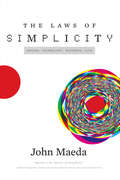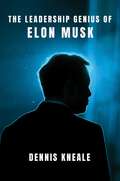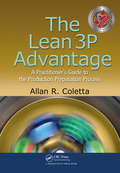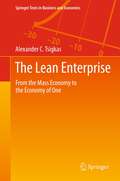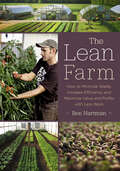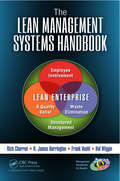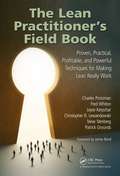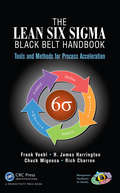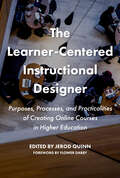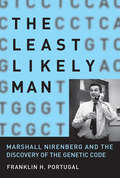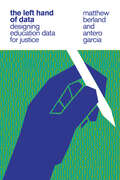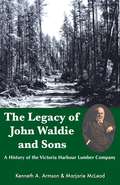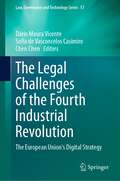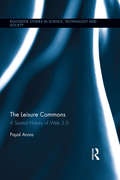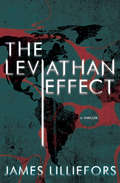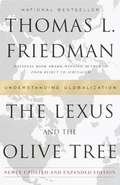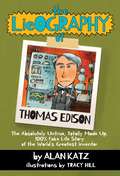- Table View
- List View
The Laws of Simplicity: Design, Technology, Business, Life
by John MaedaTen laws of simplicity for business, technology, and design that teach us how to need less but get more. Finally, we are learning that simplicity equals sanity. We're rebelling against technology that's too complicated, DVD players with too many menus, and software accompanied by 75-megabyte "read me" manuals. The iPod's clean gadgetry has made simplicity hip. But sometimes we find ourselves caught up in the simplicity paradox: we want something that's simple and easy to use, but also does all the complex things we might ever want it to do. In The Laws of Simplicity, John Maeda offers ten laws for balancing simplicity and complexity in business, technology, and design—guidelines for needing less and actually getting more. Maeda—a professor in MIT's Media Lab and a world-renowned graphic designer—explores the question of how we can redefine the notion of "improved" so that it doesn't always mean something more, something added on.Maeda's first law of simplicity is "Reduce." It's not necessarily beneficial to add technology features just because we can. And the features that we do have must be organized (Law 2) in a sensible hierarchy so users aren't distracted by features and functions they don't need. But simplicity is not less just for the sake of less. Skip ahead to Law 9: "Failure: Accept the fact that some things can never be made simple." Maeda's concise guide to simplicity in the digital age shows us how this idea can be a cornerstone of organizations and their products—how it can drive both business and technology. We can learn to simplify without sacrificing comfort and meaning, and we can achieve the balance described in Law 10. This law, which Maeda calls "The One," tells us: "Simplicity is about subtracting the obvious, and adding the meaningful."
The Leadership Genius of Elon Musk
by Dennis KnealeAn admiring portrait of the pioneering entrepreneur from the former CNBC host and Forbes editor. One of the most influential figures of our time, Elon Musk is the most talked about man in America who isn’t running for president (yet!). In The Leadership Genius of Elon Musk, veteran business journalist Dennis Kneale chronicles Musk’s extraordinary journey, presenting him as a beacon of inspiration. Musk’s unparalleled success as an innovator and entrepreneur is not just a testament to his genius, but a playbook for those daring to dream big.Synonymous with groundbreaking advancements and daring ventures, Elon Musk has not only shaped the future with companies like Tesla, SpaceX, Neuralink, the Boring Company, and xAI, but has also redefined what it means to be a leader today. Despite facing relentless criticism and controversy, Musk's relentless pursuit of his visions provides invaluable lessons about resilience, innovation, and the power of conviction. Filled with counterintuitive advice like “Tease your critics and torture your enemies” and “work impossible hours and make them keep up,” this illuminating biography reveals how the richest man in the world got that way.Kneale delves into the essence of Musk’s philosophy, dissecting the principles that have guided his extraordinary journey. From embracing the possibility of the impossible to the strategic handling of critics and media, Musk's approach to life and business offers a unique blueprint for success in today's fast-paced world. His ability to dream big, bet on himself, and turn crises into opportunities serves as a masterclass in achieving greatness against all odds.
The Lean 3P Advantage: A Practitioner's Guide to the Production Preparation Process
by Allan R. ColettaHow do you take talented engineers and surround them with the elements needed to create brilliant designs that lead to market-changing products? Lean 3P is how.Winner of a 2013 Shingo Research and Professional Publication Award !Written from an operations perspective, The Lean 3P Advantage: A Practitioner‘s Guide to the Production Preparation Proce
The Lean Enterprise
by Alexander TsigkasThe book is divided into three parts. Part I. The Rising economy of "one" gives an overview of what is changing in the social system of production, it refers to the weakening role of central planning and the rising power of individuation in the value creation chain. Part II. Lean Enterprise in theory refers to the principles of lean thinking, the transfer of lean philosophy from East to West and discusses the necessary adaptation to the Western way of thinking and practice. It presents a practice proven method for achieving a lean integrated demand and supply chain and analyses in detail the related implementation steps. Criteria for a successful displacement of a company to a lean state are presented. Part III. Lean Enterprise in practice provides a number of implementation cases in different types of production companies using the method presented in Part II. The goal is to help the reader comprehend how the method can be applied to real lean implementation situations in resolving various issues, ranging from production to the supply chain. A vision of implementation to lean electricity completes the book.
The Lean Farm Guide to Growing Vegetables: More In-Depth Lean Techniques for Efficient Organic Production
by Ben HartmanAt Clay Bottom Farm, author Ben Hartman and staff practice kaizen, or continuous improvement, cutting out more waste—of time, labor, space, money, and more—every year and aligning their organic production more tightly with customer demand. Applied alongside other lean principles originally developed by the Japanese auto industry, the end result has been increased profits and less work.In this field-guide companion to his award-winning first book, The Lean Farm, Hartman shows market vegetable growers in even more detail how Clay Bottom Farm implements lean thinking in every area of their work, including using kanbans, or replacement signals, to maximize land use; germination chambers to reduce defect waste; and right-sized machinery to save money and labor and increase efficiency. From finding land and assessing infrastructure needs to selling perfect produce at the farmers market, The Lean Farm Guide to Growing Vegetables digs deeper into specific, tested methods for waste-free farming that not only help farmers become more successful but make the work more enjoyable. These methods include:Using Japanese paper pot transplantersBuilding your own germinating chambersLeaning up your greenhouseMaking and applying simple compostsUsing lean techniques for pest and weed controlCreating Heijunka, or load-leveling calendars for efficient planningFarming is not static, and improvement requires constant change. The Lean Farm Guide to Growing Vegetables offers strategies for farmers to stay flexible and profitable even in the face of changing weather and markets. Much more than a simple exercise in cost-cutting, lean farming is about growing better, not cheaper, food—the food your customers want."With this book, however, I believe Ben has taken our craft to new levels with fresh ideas and different strategies.&”—Jean-Martin Fortier, author of The Market Gardener
The Lean Farm: How to Minimize Waste, Increase Efficiency, and Maximize Value and Profits with Less Work
by Ben HartmanA practical, systems-based approach for a more sustainable farming operation&“Ben Hartman has revolutionized his methods, cut down his work hours dramatically, and shrunk the size of his farm, all while making a better income.&”—Civil EatsTo many people today, using the words &“factory&” and &“farm&” in the same sentence is nothing short of sacrilege. In many cases, though, the same sound business practices apply whether you are producing cars or carrots. Author Ben Hartman and other young farmers are increasingly finding that incorporating the best new ideas from business into their farming can drastically cut their wastes and increase their profits, making their farms more environmentally and economically sustainable. By explaining the lean system for identifying and eliminating waste and introducing efficiency in every aspect of the farm operation, The Lean Farm makes the case that small-scale farming can be an attractive career option for young people who are interested in growing food for their community.Working smarter, not harder, also prevents the kind of burnout that start-up farmers often encounter in the face of long, hard, backbreaking labor.Lean principles grew out of the Japanese automotive industry, but they are now being followed on progressive farms around the world. Using examples from his own family&’s one-acre community-supported farm in Indiana, Hartman clearly instructs other small farmers in how to incorporate lean practices in each step of their production chain, from starting a farm and harvesting crops to training employees and selling goods.Inside The Lean Farm you&’ll discover how to apply lean practices like:Every Tool In Its PlaceTen Types of Farm WasteEstablish Pull, Don&’t PushLimits of LeanLean for More Profitand much more!While the intended audience for this book is small-scale farmers who are part of the growing local food movement, Hartman&’s prescriptions for high-value, low-cost production apply to farms and businesses of almost any size or scale that hope to harness the power of lean in their production processes.Ben Hartman was named a &“Grist 50! Fixer&”&“The Lean Farm should be dissected, digested, and discussed—then applied—on every single farm: big or small, wholesale or retail, livestock or produce. It would make all farms more profitable, productive, and pleasurable.&”—Joel Salatin, owner of Polyface Farm
The Lean Management Systems Handbook (Management Handbooks for Results)
by H. James Harrington Frank Voehl Rich Charron Hal WigginPerformance management, the primary focus of a Lean organization, occurs through continuous improvement programs that focus on education, belief systems development, and effective change management. Presenting a first-of-its-kind approach, The Lean Management Systems Handbook details the critical components required for sustainable Lean management.
The Lean Micro Farm: How to Get Small, Embrace Local, Live Better, and Work Less
by Ben Hartman&“Ben Hartman is a true innovator for the small farm.&”—Curtis Stone, author of The Urban FarmerIt&’s time to think big about small farms. Award-winning author and &“green leader&” (Grist) Ben Hartman shares practical how-to tips, personal stories, and surprising examples of cutting-edge farmers and innovators around the world to show us how.In the early 1970s, US Agriculture Secretary Earl Butz infamously commanded farmers to &“get big or get out.&” In The Lean Micro Farm, author Ben Hartman rejects that disastrous suggestion and instead takes up the charge of the late agrarian thinker Gene Logsdon: &“Get small and stay in.&”Taking inspiration from the groundbreaking ideas of E. F. Schumacher and Mahatma Gandhi, The Lean Micro Farm shows how small, hyperlocal farms can be both ecologically and economically superior to industrial-scale operations geared toward export and commodity markets.The Lean Micro Farm details the author&’s remarkable journey to downsize his farm from one acre to a third of an acre in an effort to prioritize family and community over work, all without taking a pay cut. In addition, Hartman profiles six innovative farmers from across the globe who embody this &“get small&” mindset. These pioneering farmers show all of us a path toward resilience in the face of supply chain disruption, globalization, and climate change. They model a gentler, more ecological approach to farming that produces less waste and uses less plastic, petroleum, and fertilizer.Like his previous two books, The Lean Farm and The Lean Farm Guide to Growing Vegetables, Hartman&’s The Lean Micro Farm doesn&’t just explain why smaller is better, it shows readers exactly how it can be done with step-by-step guides on how to turn a profit from a tiny, but productive, parcel of farmland. Readers will find not just philosophical justifications for a minimalist approach to agriculture but also actionable information for starting your own profitable micro farm, including:A description of the &“deep mulch&” method for building fertilityInstructions on two-step bed flipping to increase production on a small footprintA guide for choosing essential tools and technologies &“with a human face&”An easy-to-follow process for making your micro farm lean and efficientA detailed plan for selling $20,000 worth of produce from your backyardIt&’s time, Hartman makes clear, to pivot to a new kind of farming—one that builds upon ancestral knowledge, nourishes communities, and puts human joy, not technology, at its center.&“Hartman has revolutionized his methods, cut down his work hours dramatically, and shrunk the size of his farm, all while making a better income.&”—Civil Eats
The Lean Practitioner's Field Book: Proven, Practical, Profitable and Powerful Techniques for Making Lean Really Work
by Charles Protzman Fred Whiton Joyce Kerpchar Christopher Lewandowski Steve Stenberg Patrick GroundsWhile there are numerous Lean Certification programs, most companies have their own certification paths whereby they bestow expert status upon employees after they have participated in or led a certain number of kaizen events. Arguing that the number of kaizen events should not determine a person's expert status, The Lean Practitioner's Field Book: Proven, Practical, Profitable and Powerful Techniques for Making Lean Really Work outlines a true learning path for anyone seeking to understand essential Lean principles.The book includes a plethora of examples drawn from the personal experiences of its many well-respected and award-winning contributors. These experts break down Lean concepts to their simplest terms to make everything as clear as possible for Lean practitioners. A refresher for some at times, the text provides thought-provoking questions with examples that will stimulate learning opportunities.Introducing the Lean Practitioner concept, the book details the five distinct Lean Practitioner levels and includes quizzes and criteria for each level. It highlights the differences between the kaizen event approach and the Lean system level approach as well as the difference between station balancing and baton zone.This book takes readers on a journey that begins with an overview of Lean principles and culminates with readers developing professionally through the practice of self-reliance. Providing you with the tools to implement Lean tools in your organization, the book includes discussions and examples that demonstrate how to transition from traditional accounting methods to a Lean accounting system.The book outlines an integrated, structured approach identified by the acronym BASICS (baseline, analyze, suggest solutions, implement, check, and sustain), which is combined with a proven business strategy to help ensure a successful and sustainable transformation of your organization.
The Lean Six Sigma Black Belt Handbook: Tools and Methods for Process Acceleration (Management Handbooks for Results)
by H. James Harrington Frank Voehl Chuck Mignosa Rich CharronAlthough Lean and Six Sigma appear to be quite different, when used together they have shown to deliver unprecedented improvements to quality and profitability. The Lean Six Sigma Black Belt Handbook: Tools and Methods for Process Acceleration explains how to integrate these seemingly dissimilar approaches to increase production speed while decreas
The Learjet History: Beginnings, Innovations and Utilization
by Peter G. Hamel Gary D. ParkLearjet 24 (24-123, N3731)Credit: Paul BowenThis book offers an unique, comprehensive retrospective on the Learjet aircraft, from the establishment by Bill Lear in the sixties, to its slow demise in 2021. It accompanies readers on a unique journey through the configuration changes, and advanced technological applications that have transformed business jets and their market in the last sixty years. Important insights are given into numerous patents and innovations that have shaped the development of new technologies and aerodynamic improvements such as the winglet. Furthermore, this book presents many special missions carried out by the Learjet family, such as VIP, business and ambulance flights, research and military projects, and the use of Learjet in aerobatics, as well as aerial photography and cinematography. With a great number of original photographs and drawings, interesting events, stories and anecdotes, this book provides today’s aeronautical and systems engineers and test pilots with an invaluable source of information and inspiration. Yet, it also offers a compelling reading to students, professionals and scientists in the aerospace field as well as to curious readers with a general interest in aeronautics. Learjet 31A (31-131, N31LR)Credit: Paul Bowen
The Learner-Centered Instructional Designer: Purposes, Processes, and Practicalities of Creating Online Courses in Higher Education
by Flower Darby Jerod Quinn“What does a new instructional designer need to know to find her or his feet when working with faculty to create online classes?” This is a practical handbook for established and aspiring instructional designers in higher education, readers who may also be identified by such professional titles as educational developer, instructional technologist, or online learning specialist. Jerod Quinn, together with a team of experienced instructional designers who have worked extensively with a wide range of faculty on a multiplicity of online courses across all types of institutions, offer key guiding principles, insights and advice on how to develop productive and collegial partnerships with faculty to deliver courses that engage students and promote enduring learning.Designing and developing online classes for higher education takes a combination of pedagogical knowledge, the ability to build trust with faculty, familiarity with frameworks on how people learn, understanding of accessibility and inclusion, and technical skills to leverage a learning management system into an educational experience. Coming from diverse backgrounds, few instructional designers enter academia well versed in all of these aspects of creating online classes. This book provides the foundation on which instructional designers can build their careers. The guiding principle that animates this book is that the student experience and successful learning outcomes are paramount, and governs discussion of course design, pedagogy, the use of multimedia and technological advances, as well as the use of different forms of interactive exercises and group assignments. The succinct, informally written chapters offer ideas and means to apply theory to the daily work of instructional design and cover the four key components that drive this work in higher education: ·Defining the scope and main design approaches of our work·Building trust with the faculty we work with·Applying frameworks of how people learn·Mastering common online instructional practices.
The Least Likely Man: Marshall Nirenberg and the Discovery of the Genetic Code
by Franklin H. PortugalThe genetic code is the Rosetta Stone by which we interpret the 3.3 billion letters of human DNA, the alphabet of life, and the discovery of the code has had an immeasurable impact on science and society. In 1968, Marshall Nirenberg, an unassuming government scientist working at the National Institutes of Health, shared the Nobel Prize for cracking the genetic code. He was the least likely man to make such an earth-shaking discovery, and yet he had gotten there before such members of the scientific elite as James Watson and Francis Crick. How did Nirenberg do it, and why is he so little known? In The Least Likely Man, Franklin Portugal tells the fascinating life story of a famous scientist that most of us have never heard of.<P><P> Nirenberg did not have a particularly brilliant undergraduate or graduate career. After being hired as a researcher at the NIH, he quietly explored how cells make proteins. Meanwhile, Watson, Crick, and eighteen other leading scientists had formed the "RNA Tie Club" (named after the distinctive ties they wore, each decorated with one of twenty amino acid designs), intending to claim credit for the discovery of the genetic code before they had even worked out the details. They were surprised, and displeased, when Nirenberg announced his preliminary findings of a genetic code at an international meeting in Moscow in 1961.<P> Drawing on Nirenberg's "lab diaries," Portugal offers an engaging and accessible account of Nirenberg's experimental approach, describes counterclaims by Crick, Watson, and Sidney Brenner, and traces Nirenberg's later switch to an entirely new, even more challenging field. Having won the Nobel for his work on the genetic code, Nirenberg moved on to the next frontier of biological research: how the brain works.
The Least Likely Man: Marshall Nirenberg and the Discovery of the Genetic Code (The\mit Press Ser.)
by Franklin H. PortugalHow unassuming government researcher Marshall Nirenberg beat James Watson, Francis Crick, and other world-famous scientists in the race to discover the genetic code.The genetic code is the Rosetta Stone by which we interpret the 3.3 billion letters of human DNA, the alphabet of life, and the discovery of the code has had an immeasurable impact on science and society. In 1968, Marshall Nirenberg, an unassuming government scientist working at the National Institutes of Health, shared the Nobel Prize for cracking the genetic code. He was the least likely man to make such an earth-shaking discovery, and yet he had gotten there before such members of the scientific elite as James Watson and Francis Crick. How did Nirenberg do it, and why is he so little known? In The Least Likely Man, Franklin Portugal tells the fascinating life story of a famous scientist that most of us have never heard of.Nirenberg did not have a particularly brilliant undergraduate or graduate career. After being hired as a researcher at the NIH, he quietly explored how cells make proteins. Meanwhile, Watson, Crick, and eighteen other leading scientists had formed the “RNA Tie Club” (named after the distinctive ties they wore, each decorated with one of twenty amino acid designs), intending to claim credit for the discovery of the genetic code before they had even worked out the details. They were surprised, and displeased, when Nirenberg announced his preliminary findings of a genetic code at an international meeting in Moscow in 1961. Drawing on Nirenberg's “lab diaries,” Portugal offers an engaging and accessible account of Nirenberg's experimental approach, describes counterclaims by Crick, Watson, and Sidney Brenner, and traces Nirenberg's later switch to an entirely new, even more challenging field. Having won the Nobel for his work on the genetic code, Nirenberg moved on to the next frontier of biological research: how the brain works.
The Left Hand of Data: Designing Education Data for Justice
by Antero Garcia Matthew BerlandA speculative framework that imagines how we can use education data to promote play, creativity, and social justice over normativity and conformity.Educational analytics tend toward aggregation, asking what a &“normative&” learner does. In The Left Hand of Data, educational researchers Matthew Berland and Antero Garcia start from a different assumption—that outliers are, and must be treated as, valued individuals. Berland and Garcia argue that the aim of analytics should not be about enforcing and entrenching norms but about using data science to break new ground and enable play and creativity. From this speculative vantage point, they ask how we can go about living alongside data in a better way, in a more just way, while also building on the existing technologies and our knowledge of the present.The Left Hand of Data explores the many ways in which we use data to shape the possible futures of young people—in schools, in informal learning environments, in colleges, in libraries, and with educational games. It considers the processes by which students are sorted, labeled, categorized, and intervened upon using the bevy of data extracted and collected from individuals and groups, anonymously or identifiably. When, how, and with what biases are these data collected and utilized? What decisions must educational researchers make around data in an era of high-stakes assessment, surveillance, and rising inequities tied to race, class, gender, and other intersectional factors? How are these complex considerations around data changing in the rapidly evolving world of machine learning, AI, and emerging fields of educational data science? The surprising answers the authors discover in their research make clear that we do not need to wait for a hazy tomorrow to do better today.
The Legacy of John Waldie and Sons: A History of the Victoria Harbour Lumber Company
by Kenneth A. Armson Marjorie McleodAt the time of his death in 1907, John Waldie, founder of the Victoria Harbour Lumber Company, was identified as "the second largest lumber operator in Canada." A young Scottish immigrant who came to Wellington Square (now Burlington, Ontario) in 1842, he rose to prominence as a wealthy merchant and ship owner. In 1885 he entered the lumber business. Active in local and federal politics, and a friend of Sir Wilfrid Laurier, he invested capital in mills, people and forests.Local history and genealogical connections are part of the Waldie story, headquartered at Victoria Harbour in Simcoe County. Documentation of the forest that the company logged, their nature, amount and sizes of logs harvested with the descriptions of the forests as they are now, throws new light and shatters some of the current myths.This little-known story provides insights into days of rampant entrepreneurialism, the world of the lumber barons and the overall impact on our Ontario forests.
The Legal Aspects of Industrial Hygiene and Safety (Sustainable Improvements in Environment Safety and Health)
by Kurt W. DregerThe Legal Aspects of Industrial Hygiene and Safety explores various legal issues that are often encountered by Industrial Hygiene and Safety managers during their careers. A description is presented of the various legal concepts and processes that often arise in the IH/S practice, including tort, contract, and administrative law. The goal is to provide IH/S managers with sufficient knowledge to be able to incorporate legal risk analysis into everyday decision-making and policy development. This book will explore the legal issues that arise in IH/S practice and will be helpful to new IH/S managers as they progress in their careers. FEATURES Explores various legal issues that are often encountered by Industrial Hygiene and Safety managers during their careers Provides insight into the legal issues and processes to IH/S managers that are traditionally only available to attorneys Improves the IH/S managers' ability to communicate complex IH/S issues to in-house counsel Presents tools and knowledge to IH/S managers so they can better consider the legal risks of the decisions they make Covers various legal concepts and processes that can arise in the IH/S practice, including tort, contract, and administrative law
The Legal Challenges of the Fourth Industrial Revolution: The European Union's Digital Strategy (Law, Governance and Technology Series #57)
by Chen Chen Dário Moura Vicente Sofia de Vasconcelos CasimiroThis book explores the concept of a fourth industrial revolution as an expression of the current technological, economic, and social changes sparked by the growing interconnectivity and intelligent automation that have emerged in the 21st century. It seeks to identify and explain the legal challenges posed by this phenomenon in four main areas: content, economy, security, and people.Part I, Content, considers e.g. the problems posed by new uses of protected works in the digital environment, and the new rules on liability for intermediary services contained in the Digital Services Act.Part II, Economy, is particularly concerned with the regulation of Big Tech in the EU’s Digital Markets Act, ecommerce and EU consumers’ rights, the taxation of online platforms, and digital advertising.Part III, Security, addresses the European Union Strategy for Cybersecurity, the use of biometric data systems and facial recognition technologies for law enforcement purposes, and the security implications of the Proposal for an EU Regulation on Artificial Intelligence, as well as the challenges entailed by the European Union’s positioning itself as a major cyber defence actor.Part IV, People, discusses the Data Protection Litigation System under the GDPR, the right to disconnect from work, the proposed EU Catalogue of Fundamental Digital Rights, the countering of terrorist propaganda online through the TERREG and the DSA, and AI and Fundamental Rights.
The Legal Dimensions of Oil and Gas in Iraq
by Rex J. ZedalisThis volume presents the first and only comprehensive examination of the legal issues surrounding international debt recovery on claims against Iraqi oil and gas. In addition to presenting a snapshot view of Iraq's outstanding debt obligations and an analysis of the significance of the theory of odious debt in the context of the Iraqi situation, the list of legal issues examined includes relevant provisions of the Iraqi Constitution of 2005, controlling Security Council resolutions, pertinent articles of the KRG oil and gas law (No. 22) of 2007 and the many nuanced and technical questions raised thereby, legal pronouncements aimed at protecting Iraqi oil and gas and those adopted in selected other nations, and general problems associated with recognition and enforcement of awards or judgments that may involve such oil and gas or revenues from the sale thereof. Also discussed are the lessons learned by the handling of the Iraq debt experience and the transferability of those lessons to future situations in which resource-rich nations may have outstanding financial obligations to other members of the world community or their nationals.
The Legal Technology Guidebook
by Kimberly Williams John M. Facciola Peter Mccann Vincent M. CatanzaroThis book explores the transformational impact of new technological developments on legal practice. More specifically, it addresses knowledge management, communication, and e-discovery related technologies, and helps readers develop the project management and data analysis skills needed to effectively navigate the current, and future, landscapes. It studies the impact of current trends on business practices, as well as the ethical, procedural, and evidentiary concerns involved. Introducing novel interactive technologies as well as traditional content, the book reflects expertise from across the legal industry, including practitioners, the bench, academia, and legal technology consultants. All of the contributing authors currently teach aspiring lawyers and/or paralegals and have identified a gap in the available instructional material. Rapid technology advances have radically changed the way we all live and work, and the legal profession is by no means exempt from the impact of these changes. In order to better assist their clients, and to better compete on the legal market, it is imperative for lawyers to understand the ethical, functional, and business consequences of new technologies on their respective practices. This book provides the necessary content by including legal technology texts, information about novel pedagogical technologies, helpful tools for managing legal technologies and IT staff, statistical methods, tips and checklists.
The Leisure Commons: A Spatial History of Web 2.0 (Routledge Studies in Science, Technology and Society #27)
by Payal AroraThere is much excitement about Web 2.0 as an unprecedented, novel, community-building space for experiencing, producing, and consuming leisure, particularly through social network sites. What is needed is a perspective that is invested in neither a utopian or dystopian posture but sees historical continuity to this cyberleisure geography. This book investigates the digital public sphere by drawing parallels to another leisure space that shares its rhetoric of being open, democratic, and free for all: the urban park. It makes the case that the history and politics of public parks as an urban commons provides fresh insight into contemporary debates on corporatization, democratization and privatization of the digital commons. This book takes the reader on a metaphorical journey through multiple forms of public parks such as Protest Parks, Walled Gardens, Corporate Parks, Fantasy Parks, and Global Parks, addressing issues such as virtual activism, online privacy/surveillance, digital labor, branding, and globalization of digital networks. Ranging from the 19th century British factory garden to Tokyo Disneyland, this book offers numerous spatial metaphors to bring to life aspects of new media spaces. Readers looking for an interdisciplinary, historical and spatial approach to staid Web 2.0 discourses will undoubtedly benefit from this text.
The Leviathan Effect: A Thriller (A\mallory Brothers Thriller Ser.)
by James LillieforsHomeland Security Secretary Catherine Blaine receives a frightening communication from a hacker identified only by the pseudonym "Janus": three recent natural disasters around the world were correctly predicted--in fact, they were manufactured, not natural at all. And, says the email, unless she does exactly as Janus instructs, more disasters are coming--and they will destroy the United States. Unaware of the crisis in Washington, investigative journalist Jon Mallory stumbles on a list of seven prominent scientists who have been murdered in recent months. When the person who had given him the list goes missing herself, Jon realizes he has unwittingly become part of a deadly chain of events. He contacts his brother, ex-CIA agent Charles, looking for help. Meanwhile, Catherine Blaine has also come to Charles for help to track down the hacker Janus and learn what frightening science is threatening the world.
The Lexus and the Olive Tree: Understanding Globalization
by Thomas L. FriedmanFrom one of our most perceptive commentators and winner of the National Book Award, a comprehensive look at the new world of globalization, the international system that, more than anything else, is shaping world affairs today. As the Foreign Affairs columnist for The New York Times, Thomas L. Friedman has traveled the globe, interviewing people from all walks of contemporary life: Brazilian peasants in the Amazon rain forest, new entrepreneurs in Indonesia, Islamic students in Teheran, and the financial wizards on Wall Street and in Silicon Valley. Now Friedman has drawn on his years on the road to produce an engrossing and original look at globalization. Globalization, he argues, is not just a phenomenon and not just a passing trend. It is the international system that replaced the Cold War system; the new, well-greased, interconnected system: Globalization is the integration of capital, technology, and information across national borders, in a way that is creating a single global market and, to some degree, a global village. Simply put, one can't possibly understand the morning news or one's own investments without some grasp of the system. Just one example: During the Cold War, we reached for the hot line between the White House and the Kremlin--a symbol that we were all divided but at least the two superpowers were in charge. In the era of globalization, we reach for the Internet--a symbol that we are all connected but nobody is totally in charge. With vivid stories and a set of original terms and concepts, Friedman offers readers remarkable access to his unique understanding of this new world order, and shows us how to see this new system. He dramatizes the conflict of "the Lexus and the olive tree"--the tension between the globalization system and ancient forces of culture, geography, tradition, and community. He also details the powerful backlash that globalization produces among those who feel brutalized by it, and he spells out what we all need to do to keep the system in balance. Finding the proper balance between the Lexus and the olive tree is the great drama of he globalization era, and the ultimate theme of Friedman's challenging, provocative book--essential reading for all who care about how the world really works.
The Liberalisation of the Telecommunications Sector in Sub-Saharan Africa and Fostering Competition in Telecommunications Services Markets
by Rachel AlemuThis study investigates whether the existing regulatory framework governing the telecommunications sector in countries in Sub-Saharan Africa effectively deals with emerging competition-related concerns in the liberalised sector. Using Uganda as a case study, it analyses the relevant provisions of the law governing competition in the telecommunications sector, and presents three key findings: Firstly, while there is comprehensive legislation on interconnection and spectrum management, inefficient enforcement of the legislation has perpetuated concerns surrounding spectrum scarcity and interconnection. Secondly, the legislative framework governing anti-competitive behaviour, though in line with the established principles of competition law, is not sufficient. Specifically, the framework is not equipped to govern the conduct of multinational telecommunications groups that have a strong presence in the telecommunications sector. Major factors hampering efficient competition regulation include Uganda's sole reliance on sector-specific competition rules, restricted available remedies, and a regulator with limited experience of enforcing competition legislation. The weaknesses in the framework strongly suggest the need to adopt an economy-wide competition law. Lastly, wireless technology is the main means through which the population in Uganda accesses telecommunications services. Greater emphasis should be placed on regulating conduct in the wireless communications markets.
The Lieography of Thomas Edison: The Absolutely Untrue, Totally Made Up, 100% Fake Life Story of the World's Greatest Inventor (Lieographies Ser. #1)
by Alan KatzThomas Edison, world-class inventor. You might know that he devised the electric light bulb and the phonograph. But what about his development of train-controlling sticks? Or his airborne way to send pancakes to his Cousin Fran in Texas? You&’re about to be treated to the Lieographical aspects of Thomas Edison&’s life, in this funny, lighthearted, &“all that didn&’t happen&” take on the man whose inventions transformed our daily existence. The book ends with a short—but true—account of Edison&’s life—just enough to encourage kids to find out more on this important historical figure. But even if readers have already learned about Edison, the wacky stories in this tall-tales book will be even more enjoyable.
